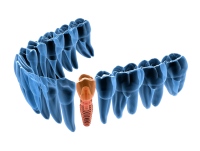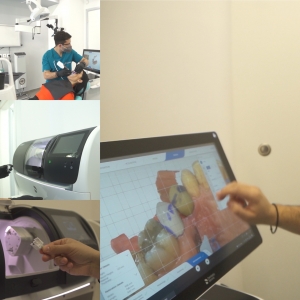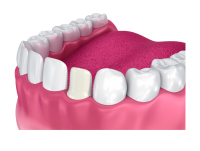Dental Implants
In our time we have run a huge expansion of technology in all areas of science, as well as implementation of scientific development in all areas of life. Medical science followed with quick steps the individual technology development at many levels. Computed tomography, magnetic resonance imaging, interventional cardiology, etc. are areas where modern medical science has made revolutions. In dental science a major achievement was the discovery of the process of osseointegration which led to the implementation of intra-osseous implants.
Studies in patients undergoing implant therapy, both with fixed and removable restorations, found that patients either wore dentures or extended bridges chewed equally well. Also, study groups that had been treated with implants could chew hard foods such as carrots, nuts, apples and hard meat, which was not done in patients with whole dentures without implant therapy.
In evaluating prosthetic work, the patient’s opinion must also be evaluated, because research has shown a correlation between evaluating the quality of prosthetic work when evaluated by patients and clinicians. However, the overall importance of treatment with dental implants should be given to the patient. Treatment with osteogenic implants does not fully replace the physical function of chewing, but the particular necessity of each patient.
Recent investigations among patient groups have shown that the group that had dentures placed on the implants could have greater chewing capacity and greater adaptation to the artificial denture.
Before going into the description of the individual cases of implant therapy we need to explain the form of a dental implant. The usual form is the existence of two or three segments that are interconnected with each other or in the form of bolted or folded segments. The first coil is the part that is essentially bonded to the bone and consists of a smooth or threaded outer titanium construction that forms the base of the implant. It may be coated with titanium spray or hydroxyapatite, techniques that promote osteosynthesis, or coated with titanium gas furnaces. The second part is always the transvaginal part, that is, the part that crosses the gingival gums and is the support site for prosthetic work or precision fasteners under the dentures. They are bonded with titanium screws to form the whole implant – prosthetic work. The process of osteosynthesis is defined as the ankle bond resulting from the growth of new bone around the metal region, and is currently the most accepted method for stabilizing dental implants and in situ prostheses ( orthopedic procedures for femoral head replacement etc.). The technique was discovered by Swedish professor Braenemark after observing that titanium blades inserted into human jaws were difficult to remove.
Patients who do not get the expected results from implantation techniques are irradiated patients, people with metabolic diseases like diabetes mellitus, collagen diseases, untreated periodontal disease, excessive smokers etc. It is typical that dental implants are also used. resembles that of natural teeth and reacts with peripheral bone loss like a natural

Τοποθέτηση Εμφυτευμάτων
Αντιμετωπίζουμε πολύπλοκα περιστατικά σε συνδυασμό με τοποθέτηση εμφυτευμάτων και επιλεγμένων προθετικών μεθόδων.

Ρομποτική Οδοντιατρική
Η επανάσταση της ψηφιακής τεχνολογίας στην οδοντιατρική είναι η ρομποτική που εφαρμόζεται μέσω του συστήματος CEREC@

Smile
Design
Πλήρης έλεγχος και επανασχεδιασμός του οδοντικού φραγμού πριν την τέλεση οποιασδήποτε εργασίας.

Όψεις
Πορσελάνης
Σύγχρονα Ολοκεραμικά υλικά που επιτρέπουν την κατασκευή πολύ λεπτών εργασιών με ελάχιστη προπαρασκευή.
Κλείστε Ραντεβού Online
Συμπληρώστε τη φόρμα με τα στοιχεία σας και την επιθυμητή ώρα και ημέρα για το ραντεβού σας με τον Ιατρό.
